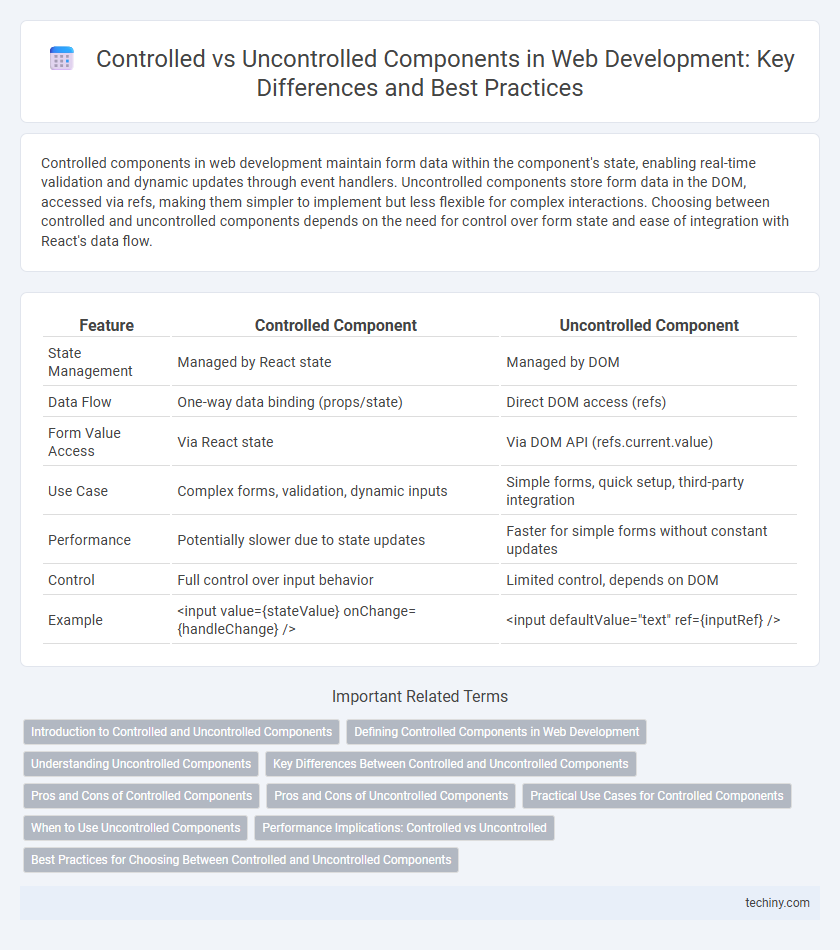Controlled components in web development maintain form data within the component's state, enabling real-time validation and dynamic updates through event handlers. Uncontrolled components store form data in the DOM, accessed via refs, making them simpler to implement but less flexible for complex interactions. Choosing between controlled and uncontrolled components depends on the need for control over form state and ease of integration with React's data flow.
Table of Comparison
| Feature | Controlled Component | Uncontrolled Component |
|---|---|---|
| State Management | Managed by React state | Managed by DOM |
| Data Flow | One-way data binding (props/state) | Direct DOM access (refs) |
| Form Value Access | Via React state | Via DOM API (refs.current.value) |
| Use Case | Complex forms, validation, dynamic inputs | Simple forms, quick setup, third-party integration |
| Performance | Potentially slower due to state updates | Faster for simple forms without constant updates |
| Control | Full control over input behavior | Limited control, depends on DOM |
| Example | <input value={stateValue} onChange={handleChange} /> | <input defaultValue="text" ref={inputRef} /> |
Introduction to Controlled and Uncontrolled Components
Controlled components in web development refer to form inputs whose values are managed by React state, ensuring synchronization between the UI and application data. Uncontrolled components rely on the DOM to handle their own state internally, accessing values through refs when needed. Understanding the distinction is crucial for optimizing form management, data validation, and user interaction within React applications.
Defining Controlled Components in Web Development
Controlled components in web development refer to form elements whose state is fully managed by React or another frontend framework, enabling developers to dictate the input values through component state. These components allow for precise control over user inputs by syncing form data with the application state, facilitating validation, conditional rendering, and dynamic user interactions. By using controlled components, forms become predictable and easier to debug, as data flow is explicitly handled within the component logic rather than relying on the DOM.
Understanding Uncontrolled Components
Uncontrolled components in web development handle form data using the DOM instead of React state, allowing form inputs to maintain their own internal state. This approach relies on refs to access the current value of input elements when needed, reducing the amount of state management code in React components. Uncontrolled components are useful for simple forms or when integrating with third-party libraries that manage their own state.
Key Differences Between Controlled and Uncontrolled Components
Controlled components in web development manage form data through React state, enabling real-time validation and dynamic input handling. Uncontrolled components rely on the DOM for form data management, using refs to access input values directly, which simplifies code but limits control over the input state. Key differences include state management, with controlled components offering synchronous updates and granular control, while uncontrolled components provide easier integration without state synchronization overhead.
Pros and Cons of Controlled Components
Controlled components in web development offer precise state management by synchronizing form inputs with React state, enabling real-time validation and consistent UI behavior. They improve predictability and simplify debugging due to explicit state control but can introduce performance overhead and verbose code for complex forms. Limited by the need for continuous state updates, controlled components may also increase development time compared to uncontrolled alternatives.
Pros and Cons of Uncontrolled Components
Uncontrolled components in web development offer simplicity by managing form data through the DOM rather than React state, reducing the need for boilerplate code and improving performance in simple use cases. However, lack of direct control over input values can complicate form validation, state synchronization, and debugging, especially in complex forms requiring dynamic updates. These components are best suited for straightforward scenarios but may hinder scalability and maintainability in large-scale web applications.
Practical Use Cases for Controlled Components
Controlled components in web development provide a reliable way to manage form inputs by syncing input values with state, making them essential for real-time validation and dynamic UI updates. They are ideal in scenarios requiring precise control over user input, such as complex form handling, conditional rendering, and immediate error feedback. React applications frequently use controlled components to enhance form consistency, improve user experience, and facilitate debugging during state changes.
When to Use Uncontrolled Components
Uncontrolled components are ideal when integrating with non-React libraries or for simple form inputs where minimal React state management is preferred. They reduce boilerplate code and improve performance by handling internal state within the DOM rather than React's virtual DOM. Use uncontrolled components for forms that do not require immediate validation or dynamic input control.
Performance Implications: Controlled vs Uncontrolled
Controlled components in web development offer precise form state management by syncing input values with React state, enhancing predictability but potentially causing more re-renders and higher memory usage. Uncontrolled components rely on the DOM for state management, reducing the number of re-renders and improving performance in complex forms but sacrificing real-time validation and state control. Choosing between controlled and uncontrolled components hinges on balancing the need for performance optimization against the requirement for fine-grained state handling and user experience.
Best Practices for Choosing Between Controlled and Uncontrolled Components
Choosing between controlled and uncontrolled components in web development depends on the need for explicit state management and form validation. Controlled components offer real-time updates and easier debugging by binding input values to state, making them ideal for complex forms requiring dynamic user interaction. Uncontrolled components provide simpler implementations suited for forms with minimal state dependencies, reducing boilerplate and improving performance when direct DOM access suffices.
Controlled Component vs Uncontrolled Component Infographic

 techiny.com
techiny.com